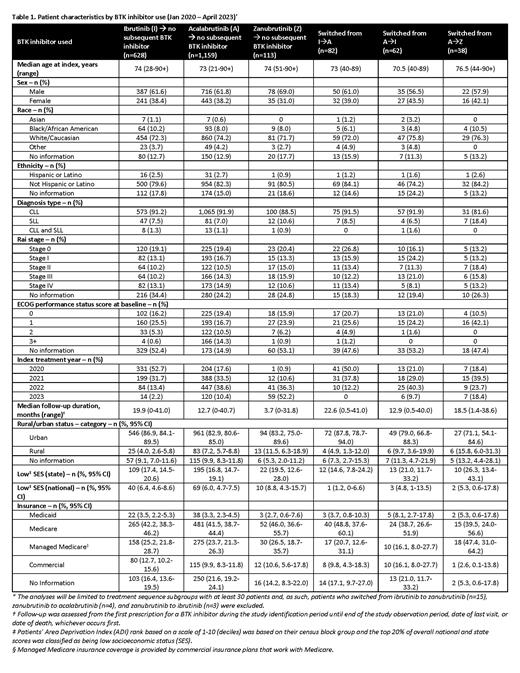BACKGROUND: The treatment landscape for patients with chronic lymphocytic leukemia or small lymphocytic lymphoma (CLL/SLL) has shifted with the introduction of second-generation Bruton tyrosine kinase (BTK) inhibitors. Few real-world studies, however, have examined sequencing patterns among BTK inhibitors for CLL/SLL and the patient characteristics across different sequences, including social determinants of health (SDOH). The aim of this study is to examine the characteristics, treatment patterns, and SDOH among patients with CLL/SLL who received BTK inhibitors in a large network of community oncology practices.
METHODS: This was a retrospective study of adult patients diagnosed with CLL/SLL who were prescribed a BTK inhibitor between 1/1/2020-4/30/2023 in The US Oncology Network. Study data were captured from structured fields in the iKnowMed electronic health record (EHR), with linkage to external sources to evaluate patients' Area Deprivation Index (ADI) scores and rural/urban status. ADI scores were determined by mapping patients' home addresses to a census block group (CBG), which was then linked to the ADI. ADI rankings are based on CBG and determined by the domains of income, education, employment, and housing quality, where high scores indicate increased disadvantage. Low socioeconomic status (SES) was defined as the top 20% of ADI scores on a national and state level (cut-off based on literature review). Rural/urban status was based on the RUCA codes published by the US Department of Agriculture. Insurance coverage was reported “as is” in the claims system with Medicaid an indicator of low SES. Results were assessed by treatment sequence, and SDOH measures results were reported as counts, frequency, and 95% confidence intervals (CI). Chi Square p-values were reported for selected SDOH measures and are shown in text. Data are presented for treatment subgroups with at least 30 eligible patients.
RESULTS: In total, 2,082 patients were included in the analysis (median age 73 years; 61.9% male; 73.5% white; 35.0% Rai stage 0-I; median follow-up 14.1 months). The highest proportion of patients received acalabrutinib or ibrutinib without an observed subsequent BTK inhibitor (n=1,159 and n=628, respectively). Patient characteristics by the top 6 treatment sequences are provided in Table 1. Demographic and clinical characteristics across the treatment sequences were similar, including sex, race, and ethnicity distributions, along with Rai stage and ECOG performance status at baseline. Across the subgroups, 8.7% (n=182) were observed to receive a subsequent BTK inhibitor. Among patients who received a BTK inhibitor in 2020 (n=597), 62.3% (n=372) received ibrutinib and a single patient received zanubrutinib. Among the 206 patients who received a BTK inhibitor in 2023, 6.8% (n=14) and 28.6% (n=59) received ibrutinib and zanubrutinib, respectively. In total, 137 patients (6.6%; 95% CI 5.6-7.7) were classified as living in rural locations. Low SES status based on state and national indicators was observed among 361 (17.3%; 95% CI 15.7-19.0) and 125 (6.0%; 95% CI 5.0-7.1) patients, respectively, and was also similar across the subgroups. The highest proportion of patients had Medicare insurance coverage (42.1%; n=877; 95% CI 40-44.3), followed by managed Medicare (24.4%; n=508; 95% CI 22.6-26.3). A statistical difference was found between the treatment regimens for rural/urban ( P<0.01), but not for state ADI ( P=0.52), national ADI ( P=0.36), or Medicaid insurance coverage vs. all others ( P=0.18). The actual values for each regimen are in the Table 1.
CONCLUSIONS: The results of this study provide insight into the shifting treatment landscape of BTK inhibitor use among patients with CLL/SLL. During the observation period, the use of ibrutinib decreased while acalabrutinib and zanubrutinib increased. When evaluating measures of SDOH, similarities across the treatment sequence subgroups suggest that patients' SES and Medicaid do not influence prescribing patterns, but rural/urban status show differences. Further real-world research and longitudinal follow-up are needed to examine the impact of SDOH on treatment choice, treatment switching, reasons for switching, and outcomes among users of BTK inhibitors. Additionally, a better understanding of the specific treatment regimen(s) and reasons driving rural/urban differences is needed.
Disclosures
Andorsky:AbbVie: Consultancy; AstraZeneca: Consultancy. Zackon:Epizyme: Consultancy; MorphoSys: Consultancy. Wilson:McKesson: Current Employment, Current holder of stock options in a privately-held company; BeiGene: Consultancy. Aguilar:McKesson: Current Employment, Current holder of stock options in a privately-held company; BeiGene: Consultancy. Wentworth:McKesson: Current Employment, Current holder of stock options in a privately-held company; BeiGene: Consultancy. Goldfarb:BeiGene: Current Employment; AstraZeneca: Ended employment in the past 24 months. Yang:BeiGene: Current Employment, Current equity holder in publicly-traded company, Membership on an entity's Board of Directors or advisory committees, Other: Travel, Accommodations, Expenses, Research Funding. Seymour:BeiGene: Current Employment, Current equity holder in publicly-traded company; Roche: Current equity holder in publicly-traded company; Flatiron Health: Ended employment in the past 24 months. Balk:BeiGene: Current Employment, Current equity holder in publicly-traded company. Maglinte:BeiGene: Current Employment; CRISPR Therapeutics: Ended employment in the past 24 months; Gilead: Current equity holder in publicly-traded company; Amgen: Current equity holder in publicly-traded company; BMS: Current equity holder in publicly-traded company.


